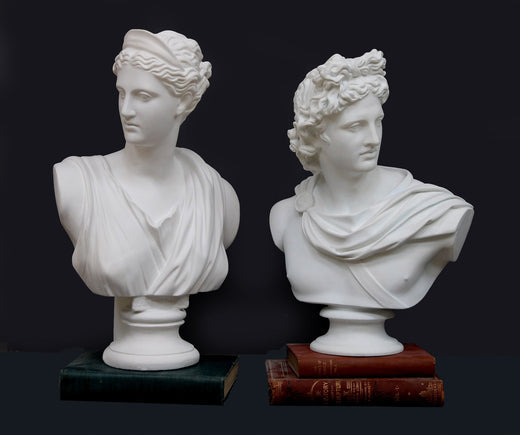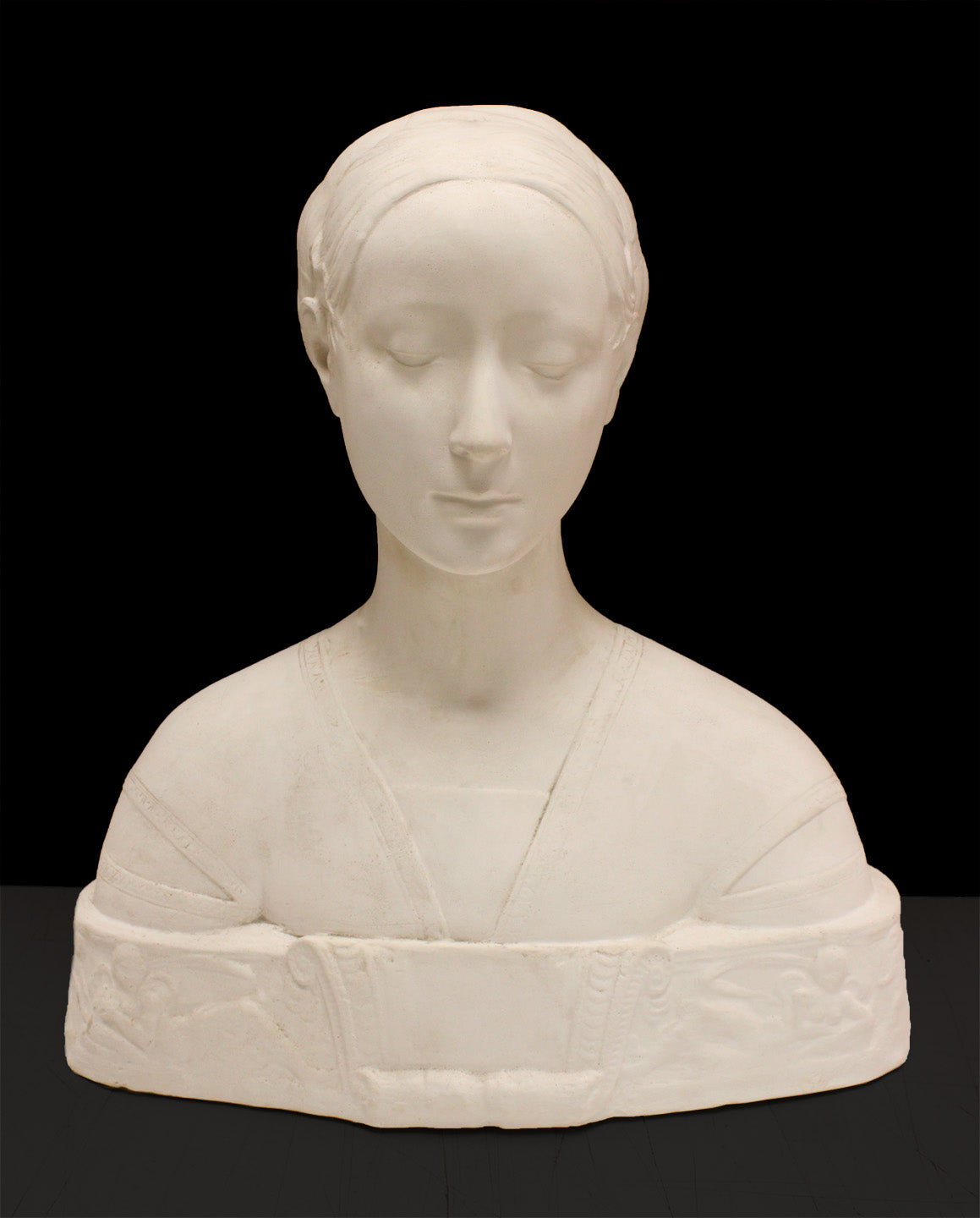The Masterpiece
Well over life-size, the Ancient Greek sculpture known as the Winged Victory of Samothrace is one of the world’s masterpieces. Victory, or Nike, is a Greek goddess who heralds victory in battle. Originally placed at the Sanctuary of the Great Gods, it is believed that the statue was meant to commemorate a Rhodian naval victory. The figure of Victory stands atop the prow of a ship, made of marble blocks; this feature still acts as the base for the sculpture in the Louvre. Victory's stance and the articulation of her drapery, which billows in places and pushes tightly against her in others, solidifies the image of the wind blowing while the ship surges forward.
Read more: Visit our site for more history and links to further reading.

The Winged Victory of Samothrace in the Louvre Museum, Caproni Collection
Restorations
The original Victory has been restored several times since her discovery in 1863, including an ambitious project that extended about 10 months during 2013 and 2014. The sculpture was deinstalled for this project, making it the second time the Victory had been removed from the Louvre’s Daru staircase. The first time was just prior to World War II when many museums evacuated and hid their collections from the Nazis. One focus of the restoration was the base, which needed to be disassembled and reassembled with the addition of new finds, and the second focus was on cleaning the statue to renew the color of the Parian marble. The removal of dirt and grime as well as previously added layers of paints and varnishes that had turned yellow with age has transformed the color of the figure from a dark yellow to the hallmark white of Parian marble. Now, the color of the statue contrasts brilliantly with the grey Lartos marble that composes the ship prow.
Read more: Take a look at the artnet article published when the Victory was back on view at the Louvre as well as the article from Emory University interviewing professor Bonna Wescoat who was a part of the team. You can also delve into this student paper that briefly discusses the history of the sculpture and the restoration.
Regarding evacuating the Louvre in World War II: Check out Lynn H. Nicholas’s book The Rape of Europa, specifically page 54, and The Observer’s 2014 article by Agnès Poirier, “Saviour of France’s art: how the Mona Lisa was spirited away from the Nazis.” You can also view a great photo here of the Victory descending the staircase taken by Pierre Jahan.
The Winged Victory of Samothrace in the Louvre Museum, Pixabay
Caproni History
Our predecessors who ran the company at the turn of the 20th century obviously admired the Victory of Samothrace. Pietro and Emilio Caproni designed the covers of the first catalogs they published of the company’s offerings in 1894 with a sketch of the Victory. They would use her image again later on the cover of the 1907 edition. Another Victory sketch graced the company’s invoices, and much later, in the 1950s, the owner used a photo of the Victory on the company’s letterhead.
Cover of the P.P. Caproni and Brother catalog published in 1894

P.P. Caproni and Brother invoice dated December 3, 1898. Courtesy of Albright-Knox Art Gallery.
The first Victory reproduction the company offered was not of the full-size original. P.P. Caproni and Brother initially created an approximately 3-foot-high reproduction. The 1894 catalog states that the Victory/Nike, item number 62, was "a mechanical reduction from the original, with wings extending about two feet from the body." This description means that it was sculpted by the company using measurements taken off the original sculpture with calipers or a pointing machine (which was commonly used at that time). They used this method often to recreate other masterpieces.

Page from the P.P. Caproni and Brother catalog published in 1894. You can see the note about the reproduction’s creation here on page 24 of the illustrated edition of the 1894 catalog. The image (a drawing) of the cast is on page 19.
In the next published catalog, dating from 1901, the company was offering a large 9-foot-high version! Not quite as tall as the original, it was 9 feet and 3 inches high and was item number 529 (see page 9 for the listing and page 109 for the halftone engraving). Page 10 lists the 3-foot-high reduction and two smaller ones as well (item numbers 752 at 3 feet high, 753 at 19 inches high, and 753A at 15 ½ inches high). The Caproni brothers even had reproductions of the prow in several sizes to place the statues atop that looked amazing! (See page 119 for the halftone engravings!)

Page 109 from the P.P. Caproni and Brother catalog published in 1901 showing Victory on the right.

Page 119 from the P.P. Caproni and Brother catalog published in 1901 showing Victory casts on a prow like in the original sculpture.
By the time the next comprehensive catalog was published in 1911, another large version of the statue was available but at 9 feet, 6 inches high and had been assigned the previous version's item number (see page 18). The company had also added several new reduced sizes. In later catalogs featuring the Victory - the last Caproni catalog was published in 1931 - some or all of the sizes were listed. Our direct predecessor, Lino Giust, only offered the 19-inch-high reduction for sale although he did have the antique casts of the 29-inch and 39-inch reproductions. Giust had not acquired the other sizes once offered by the company due to the ups and downs of the company between the 1930s and 1950s. When Robert and Kathleen Shure assumed ownership in the 1990s, they continued to offer the 19-inch reduction (item number 74), and in 2000, they decided to offer the 29-inch (item number 75), and 39-inch (item number 76) reproductions as well.

Page from the P.P. Caproni and Brother catalog published in 1911 showing Victory and the sizes available on the bottom right.
The Newest Reductions
Due to the timelessness, beauty, and popularity of the Winged Victory of Samothrace statue, we decided to create two versions of it at sizes smaller than our smallest reproduction of 19 inches high to be more affordable and more versatile in decorating. These little beauties are 12 inches high and 6 inches high.

#455 Victory of Samothrace 6" and #456 Victory of Samothrace 12"
To create them, we 3D laser scanned our antique P.P. Caproni and Brother plaster cast of the 39-inch reduction to make these reductions. We have seen the level of accuracy the 3D laser scanning and printing process is able to achieve today, such as when we made a reduction of Ceracchi’s Alexander Hamilton bust in 2018, and we were excited to utilize this technology again. Working with a local 3D printer, we were thrilled with the outcome. Our reductions accurately show the delicate fabric and feathers; they capture all of the details of our antique copy.

From left to right: #76 Victory 39", #455 Victory 6", #74 Victory 19", #456 Victory 12", and #75 Victory 29"
These new, smaller reductions - perfect for such locations as a desk or bookshelf - capture the beauty of the original sculpture at a size you can hold in your hands. Their small scale fits in numerous places in your home, office, or art studio for optimum enjoyment!
Best,
Kayla
*Please note: Additional sources used can be found on the product pages.
Want content like this delivered to your inbox? Sign up for our newsletter!



